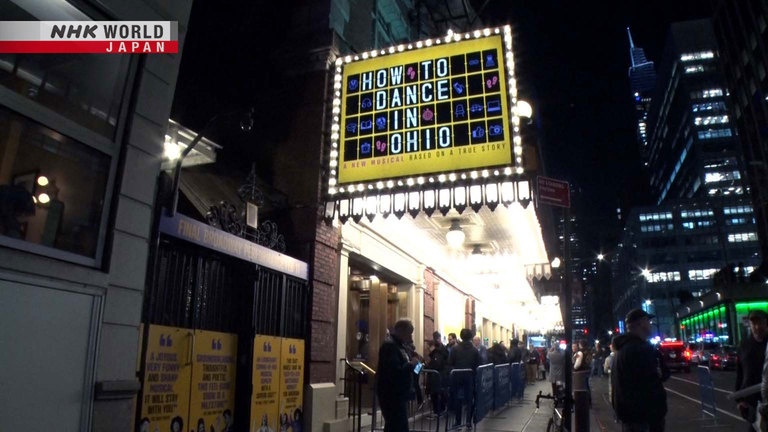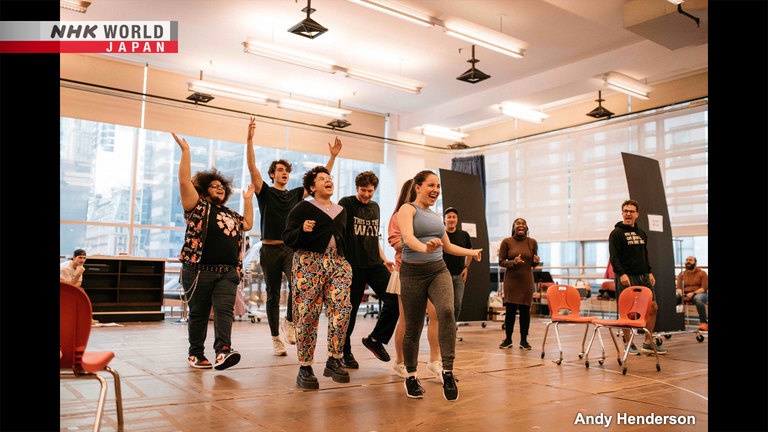Reflecting the Autistic Experience on Stage: Ava Xiao-Lin Rigelhaupt / Autistic Creative Consultant, Writer
In New York City, autistic creative consultant Ava Xiao-Lin Rigelhaupt worked with the creators of a Broadway musical to authentically represent the lived experience of autistic youth on stage.




Transcript
Direct Talk
New York City's Broadway theater district
is the pinnacle of on-stage entertainment,
with curtains going up in
around 30 theaters every night.
It is here that the musical
"How to Dance in Ohio" broke new ground,
with the heartwarming story of 7 autistic
young adults and their relationships,
performed by a cast of 7 autistic actors.
The show's creative staff is also diverse.
Ava Xiao-Lin Rigelhaupt,
is its autistic creative consultant.
There are autistic people in the world,
and so few of their stories have been told,
and you know, just like all women
wants to see a variety of women's stories
and you know, AAPI people want
the AAPI community represented on screen,
on stage and tons of nuanced,
non cliched various ways,
so does the autism community.
My mission is to create those stories
and be part of them somehow.
We ask Ava Xiao-Lin Rigelhaupt
about her mission of advancing
authentic autism representation
in the entertainment industry.
Reflecting the Autistic Experience on Stage
Hi,
welcome.
"How to Dance in Ohio"
is an original coming-of-age musical
about 7 autistic young adults who attend
group therapy at a counseling center in Ohio.
There is this saying.
If you met 1 autistic person,
you have met 1 autistic person.
You are now meeting 7 autistic people.
As part of their therapy, the 7 youngsters
prepare to attend a formal dance party.
It's a rite of passage for any teenager,
but for autistic ones, it could be
outside of their comfort zone.
With the support of their friends
and families, they face the challenge.
The autism spectrum
has a wide range of traits,
including many, which people
might not associate with autism.
This musical presents
the lived experiences of autistic people,
in a true to life manner.
We are really groundbreaking, because
we were one of the first Broadway shows
with as many out or
known autistic and disabled people
working on it on stage and behind the stage,
and also some people have other disabilities.
So a very neurodiverse
and a very inclusive, you know,
team.
And I think also, we were
one of the first Broadway shows
to be as accessible to our audience.
As the artistic creative consultant,
I work across teams
ensuring accessibility and inclusion
in everything that we do,
both internally, you know,
with our cast and crew,
but also public facing for
audience members and social media, etc.
Rigelhaupt's team created
a video for audience members
who are on the spectrum to watch
before coming to the theater,
since many often feel anxiety
going to a new place.
The lights and sounds of live theater
can be overstimulating;
so, she created cool-down spaces to relax in
and accessibility packs with
headphones and sunglasses,
to help soften the sensory stimulation.
The story of How to Dance in Ohio
is based on the award-winning
2015 documentary of the same title,
which follows a group of autistic
young people at a counselling center.
I first started working with the book
and lyrics writer Rebekah Greer Melocik
and the composer Jacob Yandura
on authentic autism representation,
and how to transfer the documentary
that's based on real people and
you know, real lives and situations
to a fictionalized musical on stage.
Rigelhaupt helped revise the script
to reflect autistic people's minds on stage.
I think those subtle changes aren't noticed
all the time by non-autistic people,
but certain language about just thinking
processes of autistic people are noticed.
One of the lines that gets
chuckled at often is,
you know, "How do I know
I want to go to the dance with them?"
I think that kind of reflects how
sometimes autistic people have trouble
naming and qualifying emotions.
So they feel something
but they don't quite know what it is.
And it just kind of represents more
autistic way of thinking on stage
instead of a neurotypical way of thinking
because sometimes neurotypicals
don't even make those connections
about life, or have those types
of questions formed that way
because their brains don't work that way.
They aren't worried,
they aren't thinking about that.
They are thinking about something else.
When she was one year old,
Ava Xiao-Lin Rigelhaupt
was adopted from China
by a Jewish American single mother.
Growing up in the United States,
she felt she was different from others,
in more ways than being
the only Asian person in her family.
I was struggling to make friends.
And we kind of knew,
you know, I would ask my mom,
you know, "Do you think I'm different?"
Or "Do you think
there's something wrong with me? "
And she would say, "No, I don't think
there's anything wrong with you."
But there's something
that we both don't understand.
And I think, because
also I was adopted again,
there was a lot of unknowns
about my background.
So doctors might not have also seen autism,
because I didn't have the typical traits.
I wasn't a boy.
I didn't have any behavioral issues.
She found a place for herself in acting.
She had no idea at the time,
but many autistic children love acting
despite the general belief
that acting is for extroverts.
I really liked acting because
acting is scripted interaction.
I always say where in life,
are you going to
know what you're going to say and
what the person is going to say in response,
how they're going to react you?
You don't, but in acting, you do.
And you can practice it again and again,
until you get really confident about
your scene and your character.
And in real life, you can't be like,
"Wait, I made a bad first impression.
Can we just like start from the beginning
and pretend that didn't happen?"
But in acting, you can.
The director of a summer theater
program Rigelhaupt attended,
noticed that Rigelhaupt might be autistic.
It led her to a diagnosis at age 18.
When I got my diagnosis,
it added, as I often say,
another facet to
my already intersectional identity
as, you know, Chinese Jewish,
transracial adoptee
with a single white mom.
And it forced me to
rethink a lot of what I knew about myself.
But through this, I started,
you know, melding my passion that I already
had for the arts and humanities and theater,
with my new interest
in inclusion and accessibility
for disabled people and autistic people.
After college, Rigelhaupt
started doing consulting work
with a non-profit for disability inclusion.
Around that time, the late Harold Prince,
a legendary director on Broadway,
was turning the documentary
"How to Dance in Ohio" into a musical.
Prince's granddaughter was autistic,
and he wanted to direct
a musical about autistic people.
After his death in 2019,
a protege took over the project
and hired Rigelhaupt
as Broadway's first
autistic creative consultant.
I was really excited.
The fact that they even just
wanted to have an artistic consultant
before they even cast the show,
in addition to casting authentically,
really showed me that they were dedicated to
doing the work of
learning about accessibility
and rethinking some of the ways
that theater conducts itself.
The open casting call proved
the depth of talent of many autistic actors,
who had not previously had the chance
to perform on Broadway.
There's so much autistic talent,
but for tons of different reasons,
possibly just haven't been given
the opportunity to be seen as much.
Some people have one view of autism,
and they often underestimate
the abilities of autistic people.
Even once we were going to
Broadway and stuff,
some of the people and
the society were hesitant, like,
you know, "Do you think your autistic
cast members can perform at this level,
you know, every single night?"
Because society just kind of
has it imbued that disabled people
aren't capable,
can't work, can't do this.
And so they were hesitant that,
you know, it would be possible.
To allow all the actors
to rehearse to their best abilities,
Rigelhaupt's team implemented
accessibility initiatives
that are uncommon in Broadway productions.
One of the mottos of our show
is accessibility at the forefront
and not as an afterthought.
We also created an access needs survey
that was sent out to all cast and crew
regardless of whether they had a disability,
and it asked simple questions, just like,
what do you need to do your best work?
What works for you
in a rehearsal room? What doesn't?
Another thing that was also
really different in contrast to
other Broadway rehearsals is that
in addition to the standard equity breaks,
we also had a policy that if you need to
step out of the room and take a break,
just tell one of the
stage managers,
and you know, it's okay to step out of the
room and take a break whenever you need to.
We reserved a cool-down space for our actors,
and had fidget toys, just like
in the baskets and things like that.
And I think it made for
much more inclusive type of room.
When the show finally opened on Broadway,
it drew positive reviews
from theater critics.
Performances also touched
the hearts of many in the audience,
whether autistic,
familiar with autism,
or not.
I loved it.
As an autistic person,
seeing myself represented on stage
was so just incredible and powerful.
All the characters are
very hard to portray correctly,
and it's very important that
they are portrayed correctly because...
- And true to life.
- True to life.
And it's really,
the way they portrayed them was...
it was amazing.
- Oh my god, we loved it.
- It was amazing. I loved it so much.
So funny, and it was
so heartfelt, and it was just
it was just so beautiful
for neurodivergent people,
and it's just such an amazing show.
It's very moving. Joyous moving, and
just, true and honest.
We might not be able to see it like tomorrow,
it might be more of a trickle down.
But I think one of the things is that it
proved that one, these types of shows
can make it to Broadway,
and people want to see
these types of stories.
As I often say, we
opened the gates to
a historically gate-kept industry
to say that, you know,
autistic actors and team members offstage
can and should be working on
Broadway and invited into that space
along with audiences.
How to Dance in Ohio had its
final performance on February 11, 2024.
Rigelhaupt continues her autism
consulting work in the entertainment industry.
And she is now writing a script for
a new children's animated TV series
premiering in the fall of 2024.
Its lead character is an autistic raccoon.
The director of
How to Dance in Ohio said that
the show isn't just a piece of art,
it is also a piece of activism.
And I really love that saying because
through art and activism,
you can sometimes
change people's perceptions
of oftentimes very stereotyped
or marginalized communities,
and through that, that might change
some hearts and minds in society.
You know.
And also through casting authentically,
it gives autistic and other disabled people
and other marginalized communities jobs.
We asked Ava Xiao-Lin Rigelhaupt
to write down some words
that keep her inspired.
I wrote
accessibility, and art plus activism
and the disability community's saying
"Nothing about us without us."
The autism community
and the disability community
want to remind people that
whenever you make something about us,
it should be with us, you know,
as writers, producers, consultants,
so that we can share our true
lived experience and it can be a better show.